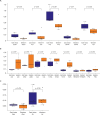Nationwide Birth Prevalence of Crucial Congenital Heart Defects From 2014 to 2018 in Korea
- PMID: 39175344
- PMCID: PMC11685341
- DOI: 10.4070/kcj.2024.0105
Nationwide Birth Prevalence of Crucial Congenital Heart Defects From 2014 to 2018 in Korea
Abstract
Background and objectives: A comprehensive survey of congenital heart disease (CHD) prevalence has not yet been conducted in South Korea. This study aimed to investigate the prevalence of CHDs in Korean children and lay the foundation for national CHD epidemiology.
Methods: Target patients were infantile crucial CHDs, which include critical CHDs (requiring urgent procedures after birth with common hypoxemic defects) and diverse categorical defects excluding simple shunt defects. Data were obtained from the National Health Insurance Service over a 5-year period (2014-2018). Birth prevalence (new cases per 1,000 live births) of CHDs in Korea was analyzed and compared with that of other countries.
Results: The birth prevalences of right heart obstructive defects (pulmonary valve stenosis and pulmonary atresia), conus anomalies (tetralogy of Fallot and double outlet right ventricle), and total anomalous pulmonary venous return showed significant increases in the East Asian group (P<0.001), whereas those of left heart obstructive defects (coarctation of aorta, aortic stenosis, and hypoplastic left heart syndrome), truncus anomalies (D-transposition of great artery and persistent truncus arteriosus), atrioventricular septal defect, and hypoplastic right heart syndrome were significantly decreased in the East Asian group (P<0.001).
Conclusions: The overall birth prevalence of crucial CHDs in Korea was similar to that of critical CHDs in previous studies from other countries. Some subtypes of right heart obstructive defects, left heart obstructive defects, and conotruncal anomalies showed significant differences between East Asian and Western populations. This study contributes to a foundation for national CHD epidemiology in Korean children.
Keywords: Congenital heart defect; Critical illness; Korea; Prevalence.
Copyright © 2024. The Korean Society of Cardiology.
Conflict of interest statement
The authors have no financial conflicts of interest.
Figures


Similar articles
-
A Comparison for Infantile Mortality of Crucial Congenital Heart Defects in Korea over a Five-Year Period.J Clin Med. 2024 Oct 29;13(21):6480. doi: 10.3390/jcm13216480. J Clin Med. 2024. PMID: 39518618 Free PMC article.
-
Cardiovascular malformations among preterm infants.Pediatrics. 2005 Dec;116(6):e833-8. doi: 10.1542/peds.2005-0397. Pediatrics. 2005. PMID: 16322141
-
Prevalence of congenital heart disease at live birth in Taiwan.J Pediatr. 2010 May;156(5):782-5. doi: 10.1016/j.jpeds.2009.11.062. Epub 2010 Feb 6. J Pediatr. 2010. PMID: 20138303
-
Consensus on timing of intervention for common congenital heart diseases: part II - cyanotic heart defects.Indian J Pediatr. 2013 Aug;80(8):663-74. doi: 10.1007/s12098-013-1039-2. Epub 2013 May 3. Indian J Pediatr. 2013. PMID: 23640699 Review.
-
Prevalence, treatment, and outcome of heart disease in live-born children: a prospective analysis of 91,823 live-born children.Pediatr Cardiol. 1989 Fall;10(4):205-11. doi: 10.1007/BF02083294. Pediatr Cardiol. 1989. PMID: 2687820 Review.
Cited by
-
The Association Between Preoperative Malnutrition and Early Postoperative Outcomes in Children with Congenital Heart Disease: A 2-Year Retrospective Study at a Lebanese Tertiary Medical Center.Children (Basel). 2025 May 29;12(6):705. doi: 10.3390/children12060705. Children (Basel). 2025. PMID: 40564663 Free PMC article.
-
Epidemiology of Valvular Heart Disease in Asia Pacific Region.JACC Asia. 2025 May 3;5(6):718-43. doi: 10.1016/j.jacasi.2025.03.011. Online ahead of print. JACC Asia. 2025. PMID: 40396937 Free PMC article. Review.
-
New Suggestion for Congenital Heart Disease Prevalence Studies.Korean Circ J. 2024 Dec;54(12):851-852. doi: 10.4070/kcj.2024.0329. Korean Circ J. 2024. PMID: 39733777 Free PMC article. No abstract available.
-
A Comparison for Infantile Mortality of Crucial Congenital Heart Defects in Korea over a Five-Year Period.J Clin Med. 2024 Oct 29;13(21):6480. doi: 10.3390/jcm13216480. J Clin Med. 2024. PMID: 39518618 Free PMC article.
References
-
- Taksande A, Jameel PZ. Critical congenital heart disease in neonates: a review article. Curr Pediatr Rev. 2021;17:120–126. - PubMed
Grants and funding
LinkOut - more resources
Full Text Sources

